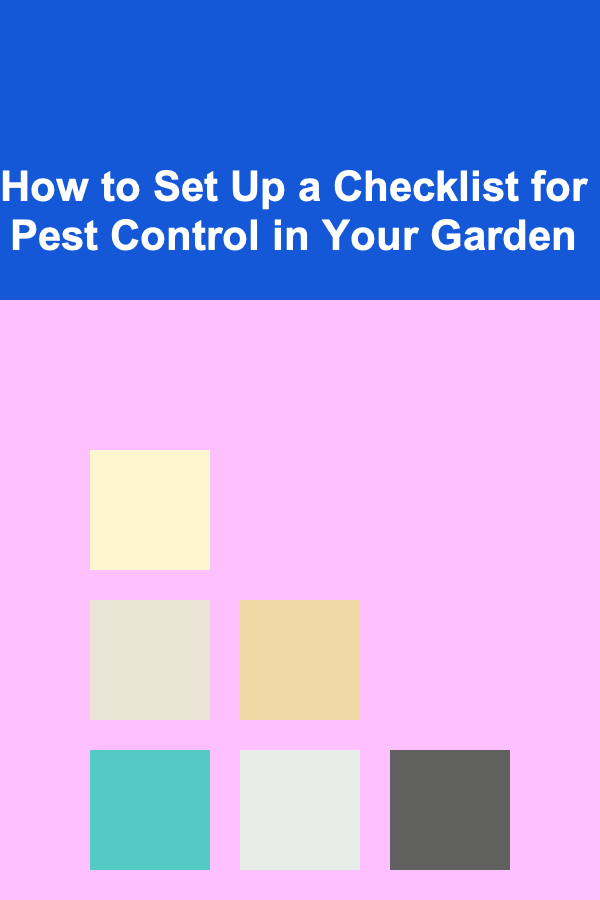
How to Set Up a Checklist for Pest Control in Your Garden
ebook include PDF & Audio bundle (Micro Guide)
$12.99$7.99
Limited Time Offer! Order within the next:

A beautiful and healthy garden is something every gardener strives for. However, maintaining that ideal environment can often be challenging due to pests that can damage your plants, flowers, and vegetables. Effective pest control is an essential part of gardening that ensures plants thrive and grow without being harmed by unwanted insects, rodents, or diseases.
Setting up a pest control checklist for your garden not only helps keep pests at bay but also ensures that you take preventive measures before problems arise. This actionable guide will help you create a detailed checklist for pest control, providing you with the necessary steps to protect your garden effectively.
Identify Common Pests in Your Garden
Before you can control pests, you need to know which ones are likely to infest your garden. Different plants attract different pests, and environmental factors such as humidity, temperature, and plant variety can influence the types of pests that invade your garden.
a. Inspect Your Garden Regularly
Regular inspection is key to identifying pests early. Look closely at your plants, especially the undersides of leaves, stems, and the soil. Some common garden pests include:
- Aphids: Small, green or black insects that suck sap from leaves and stems.
- Caterpillars: Larvae of moths and butterflies that eat through leaves.
- Spider Mites: Tiny arachnids that cause yellowing and stippling of leaves.
- Slugs and Snails: They leave a trail of slime and eat through leaves and flowers.
- Whiteflies: Tiny, white, flying insects that damage plants by sucking out their sap.
b. Know the Signs of Infestation
Familiarize yourself with the signs of an infestation:
- Discolored or damaged leaves: Yellowing, holes, or browning around the edges of leaves can signal pest damage.
- Wilting plants: When pests suck moisture and nutrients, it can lead to wilting or stunted growth.
- Sticky residue: Certain pests, like aphids, secrete a sticky substance known as honeydew that can attract ants or lead to the growth of mold.
- Presence of insects: Seeing pests on your plants during inspections is a clear sign of infestation.
Choose the Right Pest Control Methods
Once you identify the pests in your garden, it's time to decide on the most effective and sustainable methods for pest control. This decision depends on the severity of the infestation, the type of pest, and your garden's environment.
a. Cultural Practices
Preventing pest infestations can often be achieved through good gardening practices, which help to create an environment that is less inviting to pests:
- Crop rotation: Rotating crops every season helps prevent pests from becoming accustomed to a specific plant or type of crop.
- Pruning and thinning plants: Regularly remove dead or damaged parts of your plants to reduce hiding places for pests. Thinning out crowded areas also improves air circulation, making it harder for pests to thrive.
- Proper watering: Over-watering creates conditions that are conducive to certain pests like fungi and root rot. Ensure you water plants properly and use well-draining soil.
b. Physical Barriers
Sometimes, the best defense against pests is a physical barrier:
- Insect nets and row covers: Lightweight nets can be placed over plants to keep pests out while still allowing sunlight and rain to reach your plants.
- Mulching: A thick layer of mulch helps deter pests like slugs and snails while also conserving moisture for the plants.
c. Organic Pest Control
Many gardeners prefer organic pest control methods, which are safer for the environment and beneficial insects:
- Neem oil: A natural pesticide that repels a wide range of insects and has minimal toxicity to humans and animals.
- Diatomaceous earth: This fine powder is made from fossilized algae and is an effective, non-toxic way to kill pests like slugs and snails by dehydrating them.
- Insecticidal soap: A solution made from fatty acids that is effective against soft-bodied pests like aphids, spider mites, and whiteflies.
- Companion planting: Some plants repel pests naturally. For example, planting marigolds to deter aphids or basil to repel mosquitoes.
d. Chemical Control
In extreme cases, chemical pesticides may be necessary. However, these should be used with caution and as a last resort, since they can have negative effects on the environment and beneficial insects. If you choose this option, make sure to:
- Select the correct pesticide: Ensure that the chemical you're using is specifically targeted for the pest you're trying to eliminate.
- Follow safety guidelines: Read and follow all label instructions, wear protective gear, and apply pesticides during times when pollinators (like bees) are not active.
Set Up a Monitoring System
Pest control requires continuous monitoring and adjustment. Setting up a system to monitor pest activity helps ensure that your control measures are working and that your garden remains healthy.
a. Keep a Pest Journal
Create a pest control log where you record observations, pest identification, infestation levels, and the actions you've taken. This will help you track patterns, such as when specific pests are most active, so you can take proactive measures in the future.
b. Check for Pests Regularly
Schedule weekly inspections to identify any potential issues early. During these inspections, check for both visible pests and signs of pest damage.
c. Use Traps
Certain types of traps can help you monitor pest populations. For example:
- Yellow sticky traps: Effective for trapping flying insects like whiteflies and aphids.
- Slug traps: Place shallow containers of beer near plants to attract and drown slugs.
Implement Preventive Measures
Prevention is always better than a cure when it comes to pest control. Taking steps to prevent pests from infesting your garden in the first place will save you time, effort, and money in the long run.
a. Healthy Soil and Plants
The best defense against pests is a strong, healthy garden. Maintain healthy soil by adding organic matter and using compost to nourish your plants. Healthy plants are better able to withstand pest damage and disease.
b. Attract Beneficial Insects
Encourage natural predators by planting flowers and herbs that attract beneficial insects such as ladybugs, lacewings, and predatory beetles. These insects will help keep pest populations in check by feeding on harmful pests.
c. Keep Garden Clean
Remove any debris, fallen leaves, or plant material from your garden, as these can provide hiding spots for pests. Maintaining a tidy garden will make it more difficult for pests to establish a home.
Create a Seasonal Pest Control Checklist
A year-round approach to pest control is essential to ensure that your garden remains healthy through all seasons. Each season presents different pest challenges, so it's important to tailor your pest control efforts to the changing environment.
a. Spring
- Inspect for early-season pests such as aphids, caterpillars, and ants.
- Apply organic pest control methods if necessary, such as neem oil or insecticidal soap.
- Start companion planting to help deter pests later in the growing season.
b. Summer
- Continue regular inspections, focusing on pests like slugs, snails, and spider mites.
- Ensure that beneficial insects are thriving and assist in pest control.
- Apply physical barriers (like row covers) to prevent pests from laying eggs on plants.
c. Fall
- Prepare your garden for winter by clearing away dead plants and debris.
- Remove fallen fruit and leaves that could harbor pests.
- If necessary, use preventive sprays or pest repellents to deter pests that may attempt to overwinter in your garden.
d. Winter
- Inspect your garden periodically for signs of pests, especially if mild weather encourages activity.
- Plan your pest control strategies for the upcoming growing season based on the results of your past season's efforts.
Conclusion
Setting up a checklist for pest control in your garden is an essential step in maintaining a healthy and productive environment for your plants. By identifying pests early, choosing appropriate control methods, and regularly monitoring your garden, you can reduce the risks associated with pest infestations. Prevention, combined with organic control methods and seasonal adjustments, will not only protect your garden but also contribute to the long-term health and vitality of your plants. Creating a comprehensive pest control plan and sticking to it ensures that your garden remains thriving year after year.
Other Products

How to Buy the Best Baby Bedding for Safety and Comfort
Read More
How to Create an Organized Home Office with Limited Space
Read More
How to Decorate Your Home Office for Under $100
Read More
How to Explore Concentrated Solar Power with Thermal Storage
Read More
How to Organize Your Home for Better Feng Shui
Read More